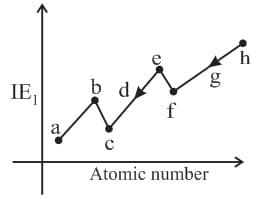How many of the following have greater than Silicon atom:
(i) (ii) (iii) (iv) (v) (vi) (vii) (viii) (ix)

Important Questions on Classification of Elements and Periodicity in Properties

Where are period elements. If the difference between the atomic numbers of elements and is and the difference between the atomic number of elements and is What is the value of
According to Slater effective nuclear charge, due to screening, is not exactly equal to the actual nuclear charge of the nucleus of the atom. depends on the type of orbital In which the electron is housed, and on the ability of other electrons
in more penetrating orbitals to screen the electron in question from the nucleus.
The relative extent to which the various orbitals penetrate the electron clouds of other orbitals is The effective nuclear charge due to screening is given by where is the atomic number and is the slater screening constant values:
| Electrons in orbitals |
per electron in orbital | ||
| etc. | |||
| or orbital | |||
| or orbital | |||
Screening effect of one electron in the outermost orbital, is not considered in calculation of
What is for
The general electronic configuration of the outermost and penultimate shell of an element is
If and then the number of protons in the nucleus of the element will be:
